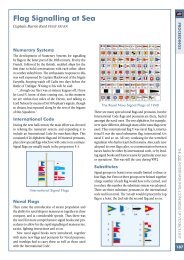The International Brigades in the Spanish War ... - The Flag Institute
The International Brigades in the Spanish War ... - The Flag Institute
The International Brigades in the Spanish War ... - The Flag Institute
You also want an ePaper? Increase the reach of your titles
YUMPU automatically turns print PDFs into web optimized ePapers that Google loves.
PROCEEDINGS<br />
154<br />
Zwolfe Februar (June 37 – 19/10/38)<br />
Volunteers from Austria, Germany and Scand<strong>in</strong>avia.<br />
Djure Djakovic o Deda Blagoiev (June<br />
1937 – 5/10/1938)<br />
Yugoslavians and Czechs.<br />
Nº 40. - Palafox (4/8/1937 – 22/10/1938)<br />
Poles, Ukra<strong>in</strong>ians, Hungarians and French.<br />
<strong>The</strong> Polish majority decided <strong>the</strong> name of <strong>the</strong> battalion:<br />
“Palafox”, <strong>in</strong> order to clean <strong>the</strong> sta<strong>in</strong> of <strong>the</strong> Polish people<br />
<strong>in</strong> <strong>the</strong> Napoleon army <strong>in</strong> Zaragoza.<br />
<strong>The</strong>ir pennant is preserved by <strong>the</strong> Militaria Arganzuela,<br />
Madrid (Fig. 40).<br />
Fig. 40<br />
In December 1937 <strong>the</strong>ir 2nd company was formed by<br />
Jewish people, under <strong>the</strong> name of Naftalí Botw<strong>in</strong> (a Polish<br />
Jew who was executed <strong>in</strong> 1925, after hav<strong>in</strong>g elim<strong>in</strong>ated a<br />
phyla-fascist spy). Poles, Ukra<strong>in</strong>ians, White Russians and<br />
Hungarians composed this company; <strong>the</strong>y had <strong>the</strong>ir own<br />
banner, newspaper and an<strong>the</strong>m <strong>in</strong> Yiddish, <strong>the</strong>ir official<br />
language. <strong>The</strong>ir banner had <strong>in</strong>scribed on it <strong>in</strong> <strong>Spanish</strong>,<br />
Yiddish, and Polish, “Company Naftali Botw<strong>in</strong>. For Our<br />
and Your Freedom.”<br />
It is said that <strong>the</strong> last casualty of <strong>the</strong> <strong>International</strong> <strong>Brigades</strong><br />
was a component of this Jewish company: Haskel<br />
Honigste<strong>in</strong>, who died on October 4, 1938.<br />
José Palafox (Zaragoza 1776 – Madrid 1847): Aragon<br />
military who assumed <strong>the</strong> defense of twice seated<br />
Zaragoza by <strong>the</strong> French troops (1808-1809).<br />
Italoespañol (4º de la XII) (10/1937 –<br />
25/9/1938)<br />
Masaryk (30/12/1937 – 5/10/1938)<br />
Czechs and some Polish.<br />
Formed <strong>in</strong> December 1937 it was <strong>the</strong> reserve battalion<br />
of <strong>the</strong> 45th division, later pass<strong>in</strong>g to <strong>the</strong> 29 BI. He<br />
covered <strong>the</strong> retreat of <strong>the</strong> army <strong>in</strong> Aragon and Catalonia.<br />
Crossed <strong>the</strong> border on 9 February 1939.<br />
<strong>The</strong>ir flag was a republican tricolour with white letters<br />
(Fig. 41).<br />
Fig. 41<br />
Tomás Masaryk (Göd<strong>in</strong>g, Bohemia 1850 – Lány,<br />
Bohemia 1937): Czech politician, ca<strong>the</strong>dratic of<br />
philosophy at <strong>the</strong> Prague University. In 1900 he<br />
was one of <strong>the</strong> founders of <strong>the</strong> Czech popular party<br />
which fought for <strong>the</strong> autonomy aga<strong>in</strong>st <strong>the</strong> Austrian-<br />
Hungarian empire. Once <strong>the</strong> <strong>in</strong>dependence obta<strong>in</strong>ed<br />
of <strong>the</strong> Czech state, he was elected president of <strong>the</strong><br />
Republic 1918-1935.<br />
Divisionario de la 35 DI<br />
Checo-balcánico [or Divisionary of <strong>the</strong> 45<br />
DI) (3/1938 – 25-10-1938)<br />
Non identified Polish Unit<br />
We could be talk<strong>in</strong>g about a flag that would be identified<br />
with <strong>the</strong> totality of <strong>the</strong> Polish brigades and not to a determ<strong>in</strong>ed<br />
company or battalion; though, <strong>the</strong> presence of a<br />
republican tie <strong>in</strong>dicates that <strong>in</strong>deed it is a flag of <strong>the</strong> unit.<br />
Luis Sorando describes it “of red trimmed silk with<br />
gold fr<strong>in</strong>ge, measures approximately 1.40 x 2.15m.<br />
It shows <strong>in</strong> <strong>the</strong> centre a huge emblem formed by <strong>the</strong><br />
red three po<strong>in</strong>t star, trimmed with f<strong>in</strong>e lively golden,<br />
on whose vertex <strong>the</strong>re is a white circle which <strong>in</strong>side it<br />
has a sky-blue semi-circle with <strong>the</strong> map of Spa<strong>in</strong> and a<br />
clenched fist and at <strong>the</strong> bottom a red five po<strong>in</strong>t star on<br />
a golden sun. In <strong>the</strong> upper part of <strong>the</strong> cloth a motto <strong>in</strong><br />
Polish JEDNOSE LUDU PRACULACEGO TOSMIERE FASZISMU!<br />
(<strong>The</strong> union of <strong>the</strong> work<strong>in</strong>g people is <strong>the</strong> thumb of fascism!)<br />
<strong>in</strong> white letters. It wears a republican three-colour<br />
tie with golden edge” (Fig. 42).<br />
Fig. 42






